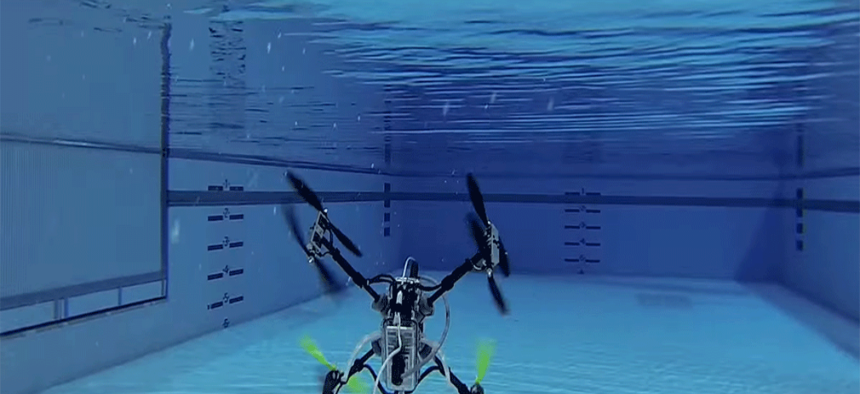New drone can both swim and fly for future Navy ops
A university team demonstrated an aerial-aquatic hybrid drone designed for future countermine operations.
Four propellers, followed by the domed top of a quadcopter drone body emerged from a pool of water and rose into the air in front of onlookers at the 2017 Future Naval Force Science & Technology Expo. The quadcopter, called the Naviator, is the first successful hybrid aerial-aquatic drone, according to the Office of Naval Research (ONR).
The Naviator is being developed by a team at the University of Rutgers School of Engineering and is sponsored by the ONR. According to a member of the Rutgers development team, a Phase Two contract for development of the drone will begin in 2018.
The drone is designed to be able to plunge almost ten meters into the water and surface and fly from that depth, if necessary.
“The Naviator’s ability to seamlessly and rapidly transition from flying in the air to maneuvering underwater provides tremendous opportunities for…naval operations,” said Professor F. Javier Diez of the Rutgers-New Brunswick School of Engineering. “As these recent tests demonstrated, what previously might require a helicopter, boat, and underwater equipment, the Naviator was able to complete as a single deployment with fewer complications and in less time.”
Beyond the demonstration at the Science & Technology Expo, the Naviator has proved itself by conducting an underwater bridge inspection of the Delaware Memorial Bridge Twin Spans, according to the Association for Unmanned Vehicle Systems International (AUVSI). The drone was also test-launched from the Cape May-Lewes Ferry.
The current model is capable of carrying a 360 degree waterproof camera, according to Dr. Marc Contarino, Vice President of technology for the Naviator program, which was used for the bridge and boat inspection test launch. However, with the sponsorship of the ONR, the development team is also designing the Naviator with an eye toward Naval operations.
In particular, a spokesperson at the Science & Technology Expo mentioned that the technology could be used for mine countermeasure operations or other special operation.
With this in mind, the development team is already planning the next generation Naviator. The goal is to create a version that is six feet in diameter and can carry a 30-pound mine countermeasure technology payload. It is also designed to achieve higher underwater depths, up to 30 meters.
“Since we’re a Navy sponsor[ed program]…It’s all about speed and not being detected, so we’re building our system to be as fast as possible,” said Dr. Contrarino.
Work is also being done to develop the Naviator’s abilities to map the ocean floor or perform search and rescue missions, according to the Association for Unmanned Vehicle Systems International.




